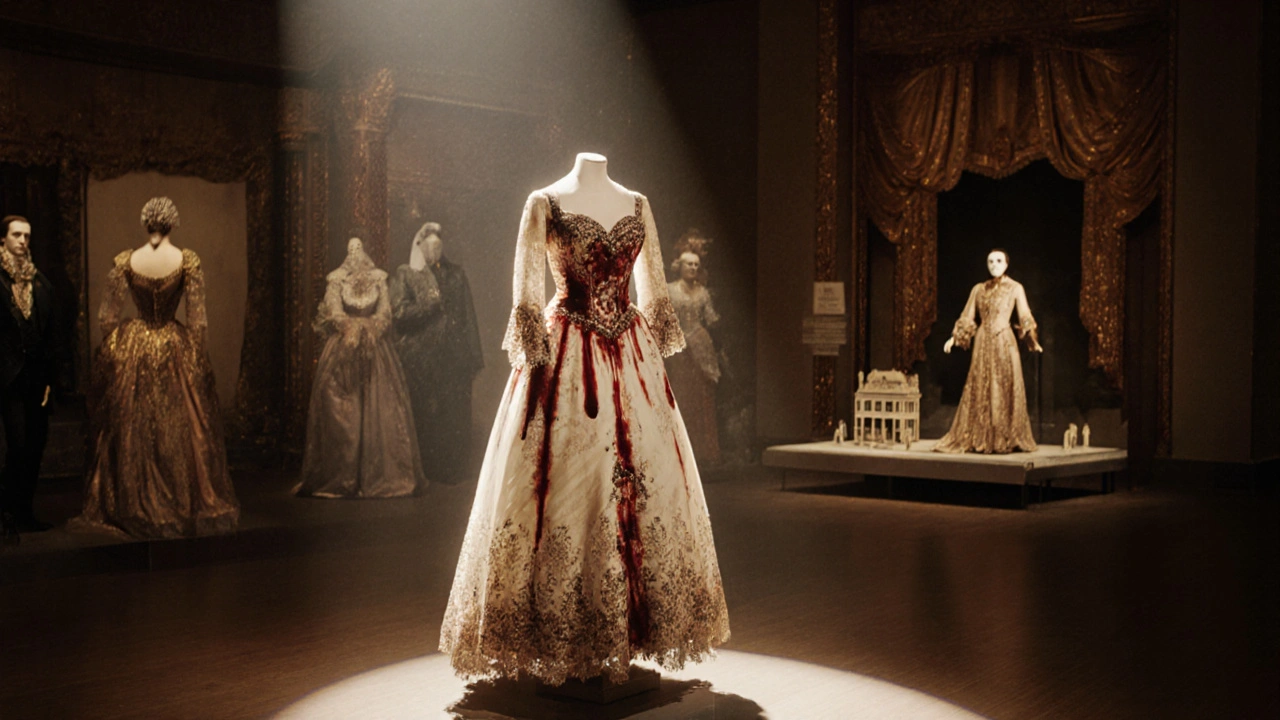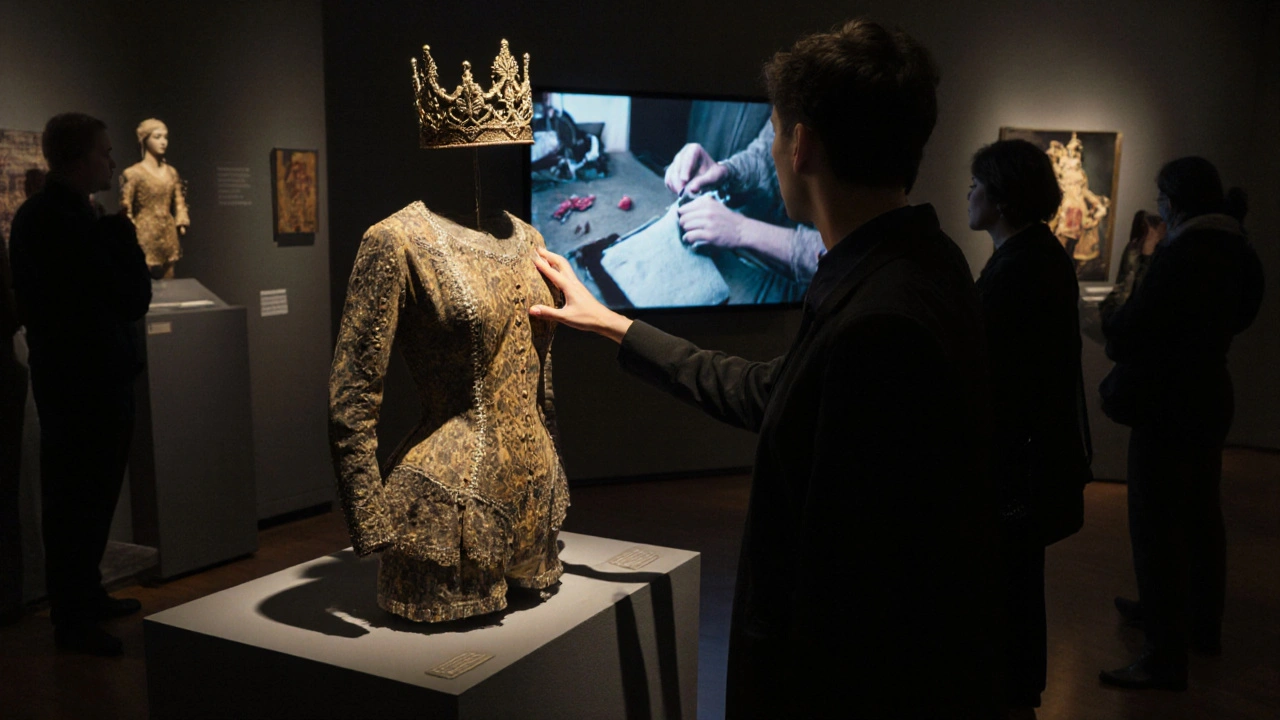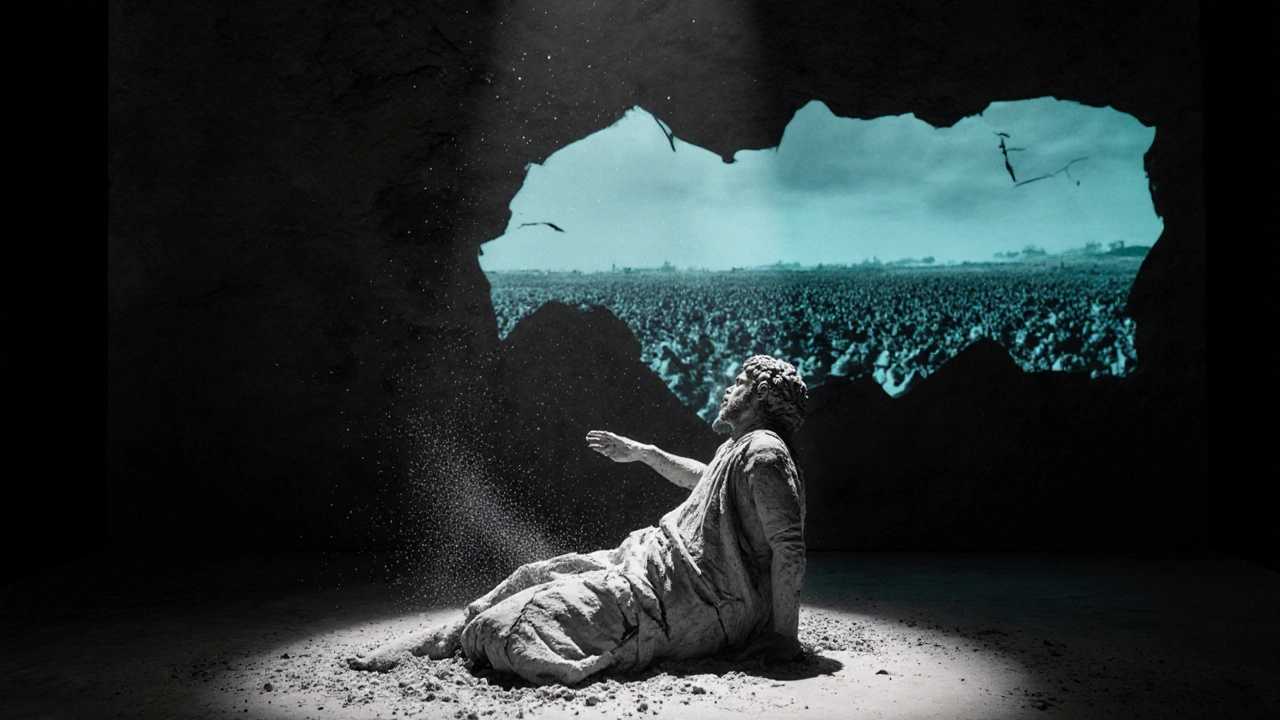
Walking through the backstreets of London’s West End, you might miss the quiet magic happening behind the velvet curtains. While audiences cheer for actors and applaud lighting cues, the real architects of those unforgettable moments-the costume designers and set builders-are often unseen. But in London, that’s changing. Over the past few years, museums and galleries have begun pulling back the curtain, turning backstage art into public exhibitions. These aren’t just displays of fabric and wood. They’re immersive stories told in thread, paint, and steel.
Why Theatre Design Belongs in a Museum
Theatre design isn’t decoration. It’s storytelling in three dimensions. A single costume can reveal a character’s social status, inner turmoil, or even their future fate. A set isn’t just a backdrop-it’s a world with its own rules of gravity, light, and time. Think of the jagged, broken towers in Macbeth at the Royal Shakespeare Company. They weren’t built to look scary. They were built to make the audience feel trapped, like the characters. That’s why these designs deserve to be seen outside the theatre.In 2023, the Victoria and Albert Museum opened Behind the Scenes: Costume and Set Design in British Theatre, featuring over 120 original pieces from productions spanning 70 years. One standout was the blood-soaked wedding dress from Phantom of the Opera (2010 London revival), stitched with real lace and hand-painted with metallic rust to mimic drying blood. It wasn’t just worn-it was performed. The dress weighed 14 kilograms. The actress couldn’t sit down. That’s design with consequences.
Where to See These Exhibitions in London
You don’t need a theatre ticket to see these works. Several venues in London now host rotating exhibitions focused on theatre design:- The Victoria and Albert Museum (South Kensington): Their permanent Theatre & Performance gallery includes original designs from Les Misérables, The Lion King, and Harry Potter and the Cursed Child. The Costume Vault lets visitors handle replicas of fabrics used in the 1980s Hamlet with silk-screened crowns that shimmered under stage lights.
- The National Theatre Archive (South Bank): Free to visit, this archive holds sketches, scale models, and fabric swatches from over 2,000 productions. Their 2025 exhibit, Building Worlds: The Art of Set Design, shows how a single cardboard box became a spaceship in War Horse-transformed by shadow and movement.
- Design Museum (Kensington): Their Stagecraft: Design as Drama exhibit (running through March 2026) compares the work of modern designers like Es Devlin with historical figures like Edward Gordon Craig. One wall displays 17 versions of the same chair from different Waiting for Godot productions, each reflecting a different philosophy of despair.
- Shakespeare’s Globe (Bankside): Their Costume Workshop Open Days let you watch designers stitch doublets by hand using 16th-century techniques. You can touch the wool dyed with woad and weldwood, the same materials used in 1599.
Many of these exhibits include touchscreens showing behind-the-scenes footage-designers measuring actors for bodices, carpenters sanding set pieces to mimic weathered stone, dye masters mixing colors to match a sunset at 7:45 p.m. on opening night.

The Craft Behind the Magic
What makes these exhibitions powerful isn’t just the final product. It’s the process. A single costume for a Shakespearean noblewoman can take 400 hours to make. That’s six weeks of work by a team of five. The fabric might be handwoven silk from Italy, dyed with natural indigo, then hand-embroidered with silver thread in a pattern that only appears under stage lighting.Set designers face different challenges. A set for 1984 at the Almeida Theatre in 2024 used 1,200 recycled plastic bottles to create a wall of surveillance. Each bottle was cut, melted, and pressed into a translucent panel. When lit from behind, it glowed like a prison cell under fluorescent tubes. The designer, Lena Voss, said she wanted the audience to feel the weight of the system-not just see it.
These aren’t museum pieces locked under glass. They’re working art. Many designs are reused, altered, and reimagined. The same crown worn by Lady Macbeth in 2012 was repurposed for a 2021 production of Medea-its jewels replaced with broken watch parts to symbolize time running out.
How Designers Work With Directors and Actors
Designers don’t work in isolation. They’re part of a tight-knit team. In rehearsals, costume designers sit in the corner with clipboards, watching how actors move. Does the corset restrict breathing? Does the cape snag on the stairs? A set designer might spend days adjusting a doorway’s height after an actor keeps bumping their head.One actor in Hamlet (2023, Old Vic) had a panic attack during a scene because the heavy velvet cloak made him feel suffocated. The costume team redesigned it overnight-replacing the lining with breathable mesh and reducing the weight by 2.3 kilograms. The actor later said the change saved his performance.
That’s the unspoken rule of theatre design: it must serve the human being on stage. No matter how beautiful, if it hurts, it fails.

What’s New in 2025
This year, London’s theatre design scene is pushing boundaries. The Royal Opera House debuted a new exhibit called Design in Motion, featuring motion-captured costumes that react to the performer’s movements. One dress, worn in a production of Swan Lake, had tiny LED threads embedded in the tulle that pulsed with the dancer’s heartbeat, tracked by a sensor sewn into the bodice.At the Young Vic, a set for Antigone was built entirely from 3D-printed clay, fired on-site. It cracked during the final performance-intentionally. The designer wanted the set to decay as the character did. The audience didn’t know it was planned until the program notes revealed it.
And for the first time, the National Theatre is releasing digital replicas of their designs. Using augmented reality, you can point your phone at a blank wall and see a full-scale model of the War Horse battlefield appear-complete with mud texture, broken fences, and the faint sound of distant horses.
Why This Matters Beyond the Stage
These exhibitions aren’t just for theatre lovers. They’re for anyone who’s ever wondered how stories become real. In a world where everything is digital, these handmade worlds remind us of the power of physical craft. They show that creativity isn’t just about ideas-it’s about sweat, patience, and problem-solving under pressure.When you see a costume from Phantom of the Opera hanging in a museum, you’re not just looking at fabric. You’re seeing a century of tradition, a team of 12 people working in silence, and a single thread that held together a million heartbeats in a darkened theatre.
London doesn’t just put on plays. It builds entire worlds-and now, you can walk through them.
Are theatre costume and set design exhibitions free to visit in London?
Many are free or included with general museum admission. The National Theatre Archive offers free entry to its design exhibits, and the Victoria and Albert Museum’s Theatre & Performance gallery is free for all visitors. Special exhibitions like Stagecraft: Design as Drama at the Design Museum may charge £12-£18, but student and under-18 tickets are often discounted. Always check the venue’s website before visiting-some offer free hours on certain weekdays.
Can I see original costumes and sets from current West End shows?
Yes, but only if they’re part of a museum exhibit. Current productions rarely display their sets and costumes during the run. Once a show closes, designers often donate pieces to institutions like the V&A or the National Theatre Archive. For example, the original crown from Hamilton (2017 London run) is now on display at the V&A. Check upcoming exhibition schedules-new pieces are added every few months.
Do these exhibitions include interactive elements?
Many do. The Design Museum lets you try on digital replicas of costumes using AR mirrors. The Victoria and Albert Museum has touchscreens showing how a dress was stitched, stitch by stitch. At Shakespeare’s Globe, you can handle fabric swatches and smell the natural dyes used in 16th-century costumes. Some exhibits even let you control lighting angles to see how a set looks at dawn versus midnight.
How long do these exhibitions usually last?
Permanent galleries, like the V&A’s Theatre & Performance collection, are always open. Rotating exhibitions typically run 6-12 months. Major shows like Behind the Scenes or Design in Motion often last 9-12 months. Smaller exhibits at the National Theatre Archive may only run 3-4 months. Always check the current schedule-exhibits change frequently.
Is there a best time of year to visit these exhibitions?
Autumn and early winter (September to December) are ideal. That’s when new exhibitions open after the summer break, and crowds are thinner than during the holiday rush. February and March are also good-many shows run through spring, and the weather is mild enough to explore multiple venues in one day. Avoid July and August if you want to skip the tourist rush.